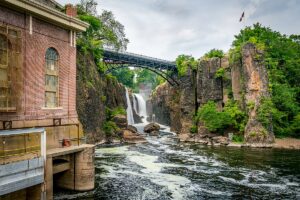This area was first inhabited by the Lenni Lenape, followed by Dutch settlers in the 17th century. Fourteen Dutch families established themselves here, later dividing up their 100-acre plots of land into smaller farm units. Almost 80 years later, in 1792, the area would be transformed due to the vision of one man.
After the Revolutionary War ended, Alexander Hamilton began promoting his views on the economic needs of the new nation. He was concerned over the lack of industry in the United States; during colonial times, it was prohibited by English law. Hamilton believed that a strong industrial system was the best way to help the United States gain financial independence and become a world presence.

 Silk cloth and steam locomotives; textiles and continuous paper rolls; firearms and aircraft engines. What do these things have in common? All were manufactured in the same place – Paterson, NJ. It was here, in America’s first planned industrial city, that the Industrial Revolution got a foothold in the New World. Centered around the Great Falls of the Passaic River, Paterson pioneered methods for harnessing water power for industrial use. In Paterson, many of the manufactories that enabled the young United States to become an economic player on the world stage, were established and promoted. In the process, Paterson experienced all the economic highs and lows that can befall an industrial center.
Silk cloth and steam locomotives; textiles and continuous paper rolls; firearms and aircraft engines. What do these things have in common? All were manufactured in the same place – Paterson, NJ. It was here, in America’s first planned industrial city, that the Industrial Revolution got a foothold in the New World. Centered around the Great Falls of the Passaic River, Paterson pioneered methods for harnessing water power for industrial use. In Paterson, many of the manufactories that enabled the young United States to become an economic player on the world stage, were established and promoted. In the process, Paterson experienced all the economic highs and lows that can befall an industrial center.